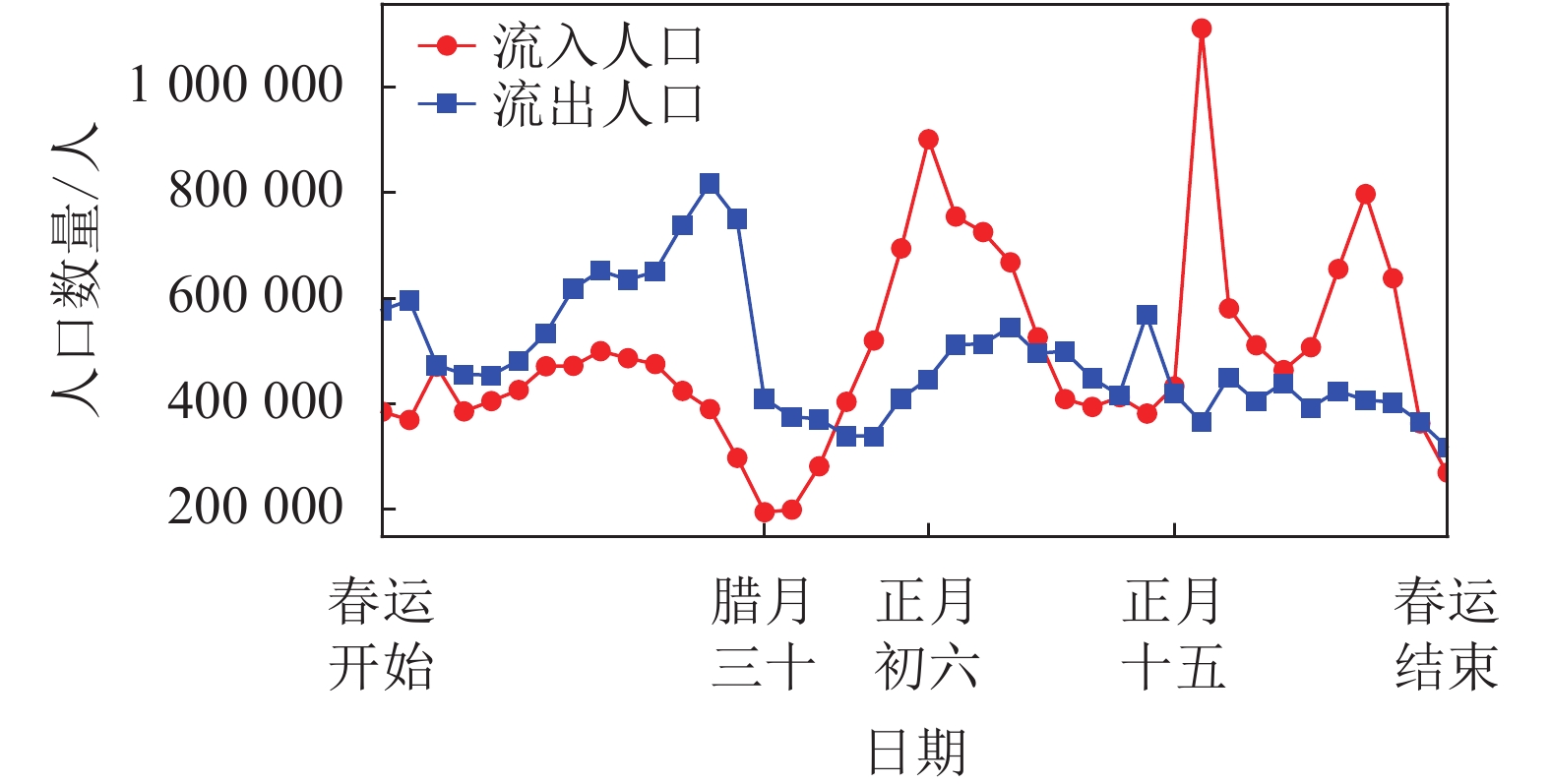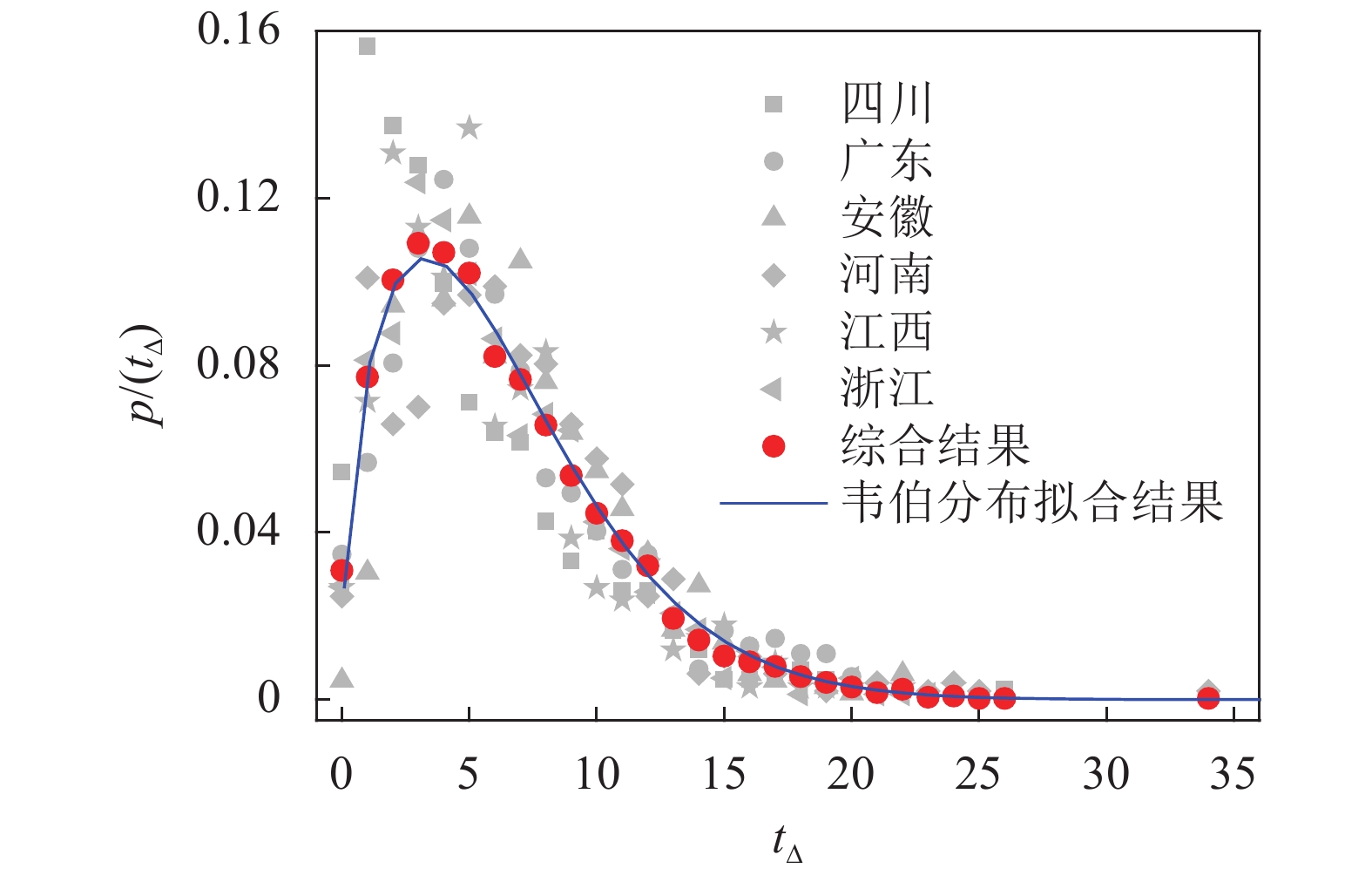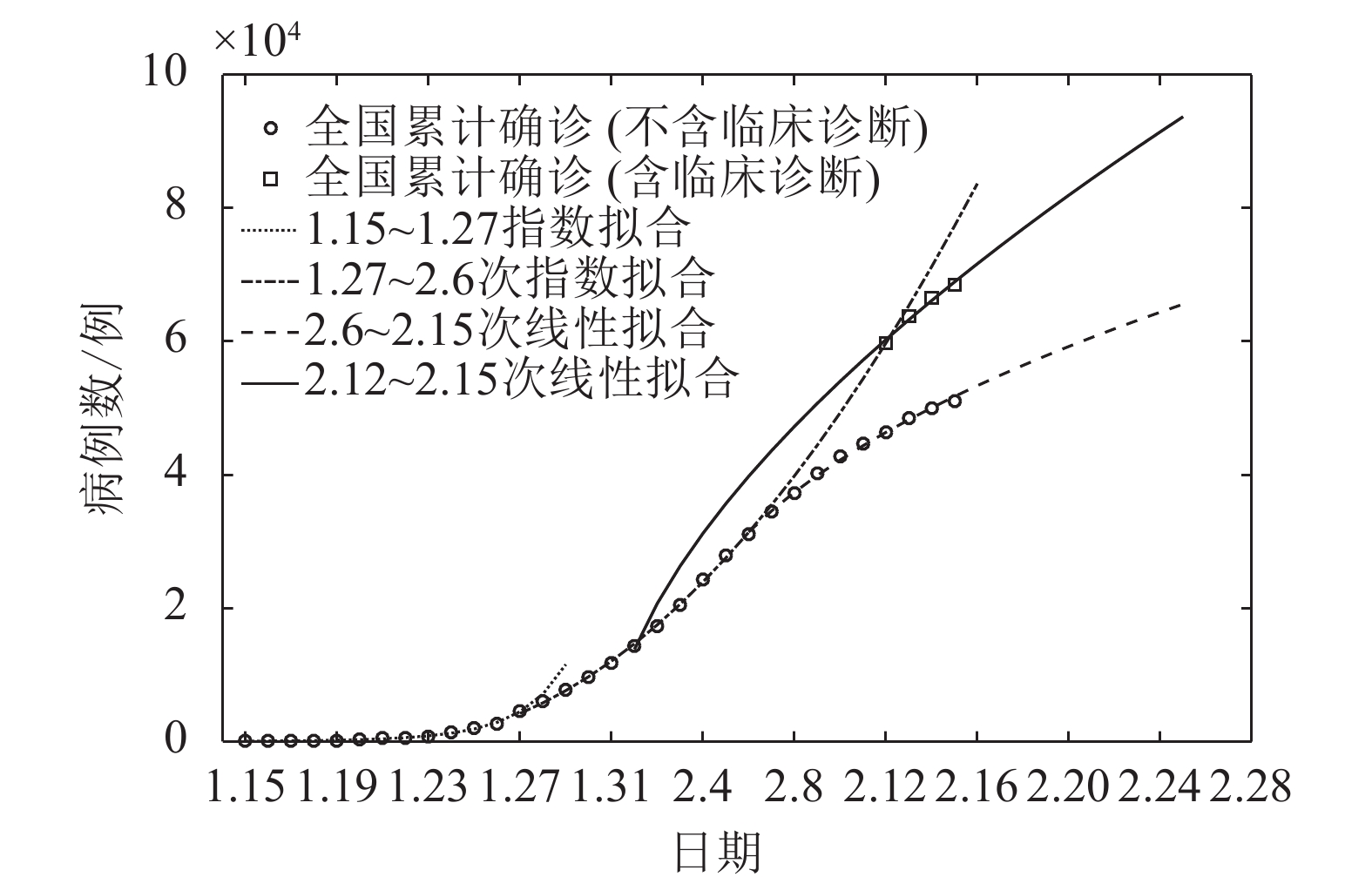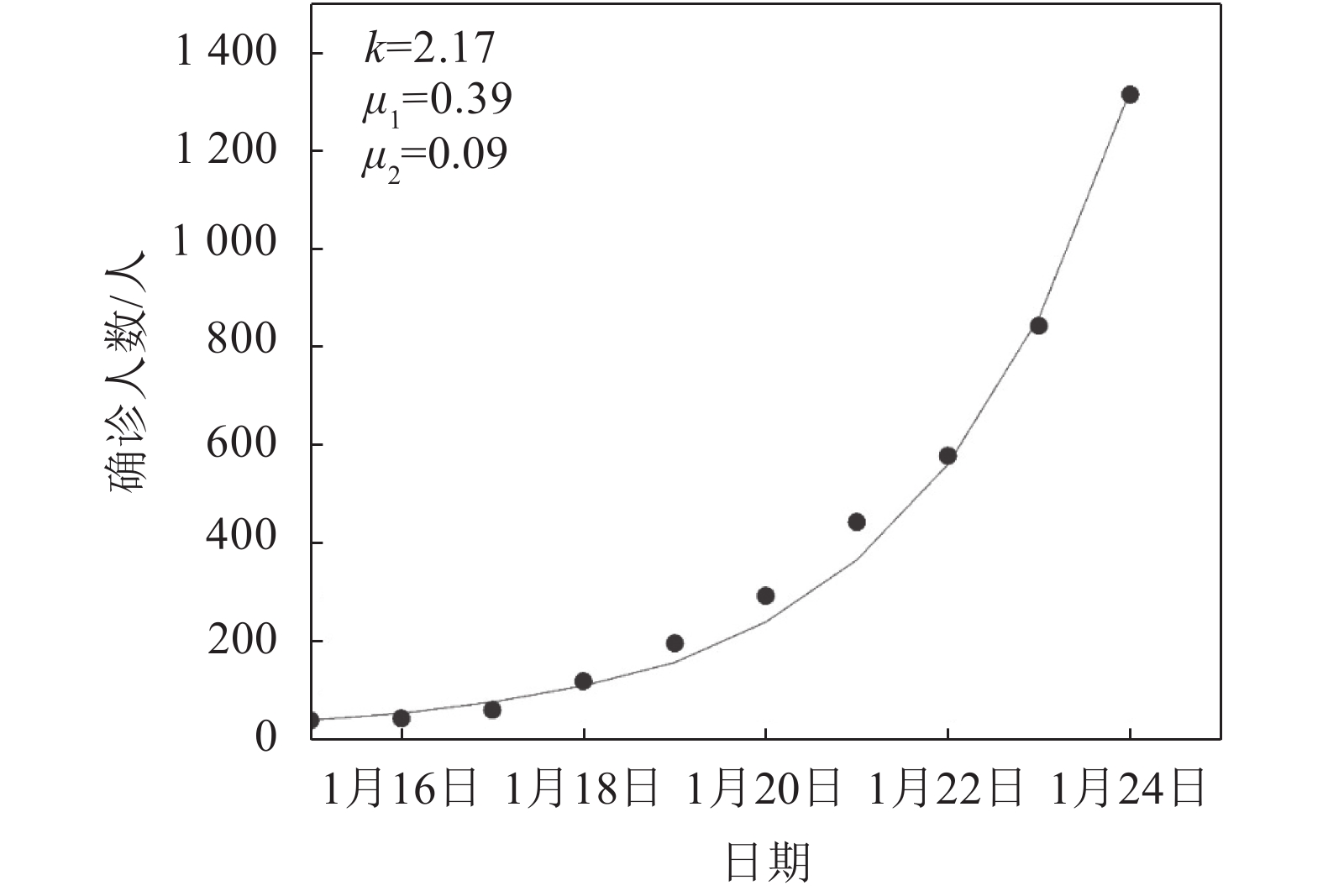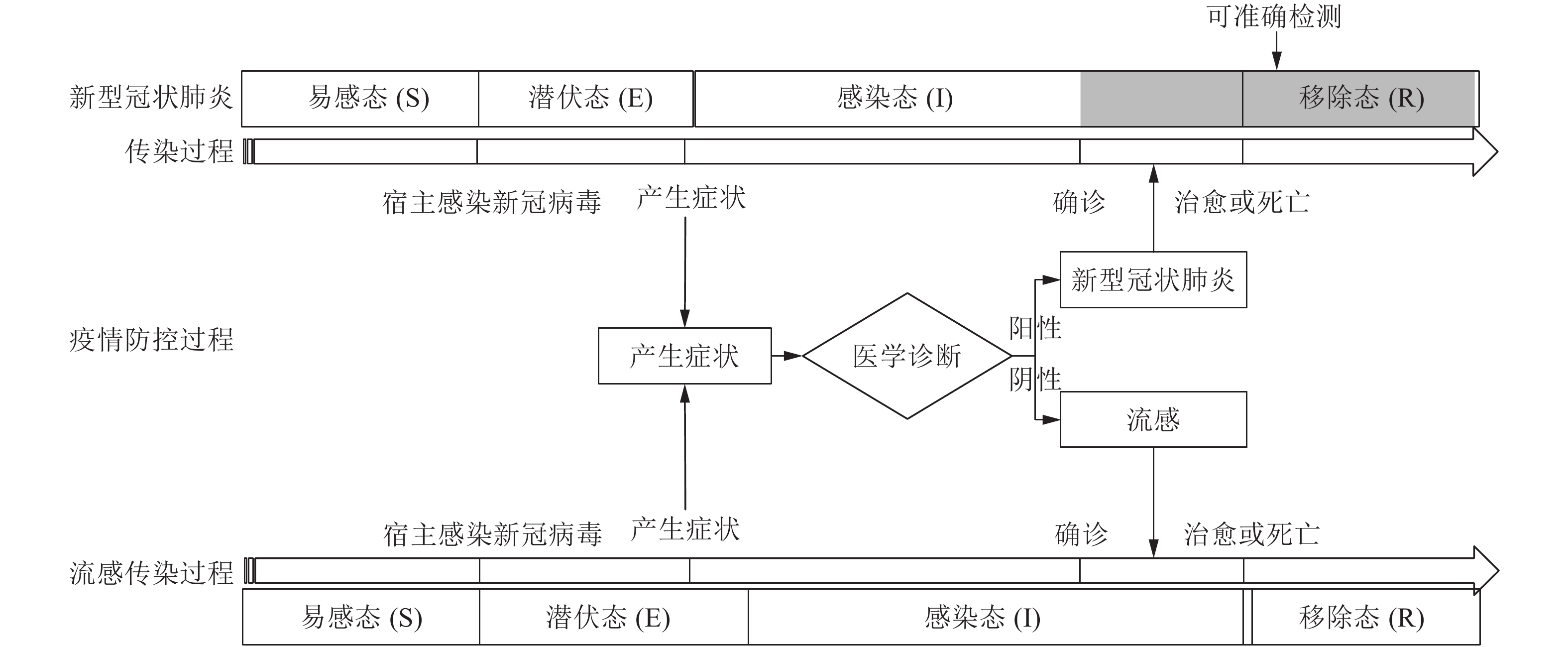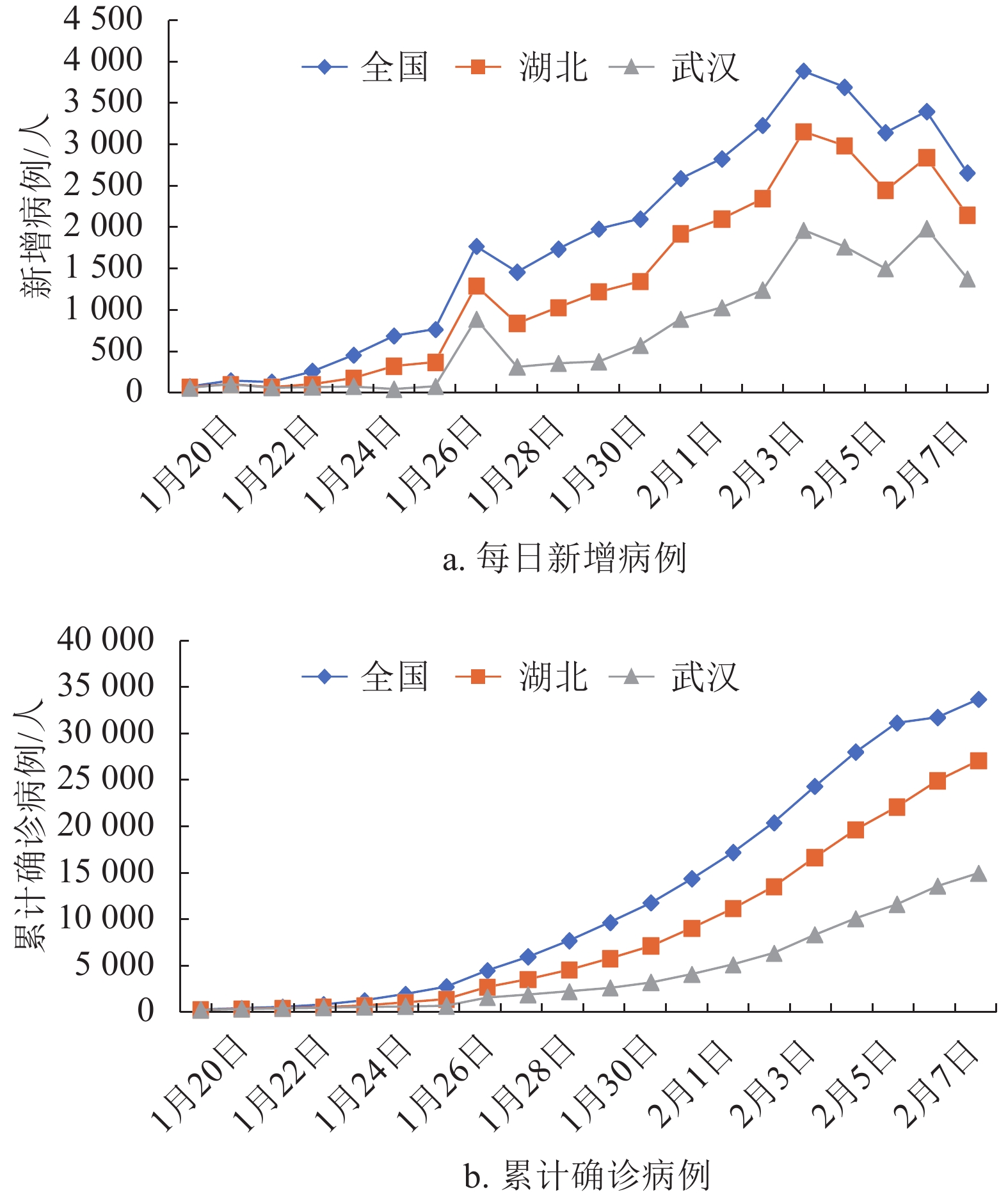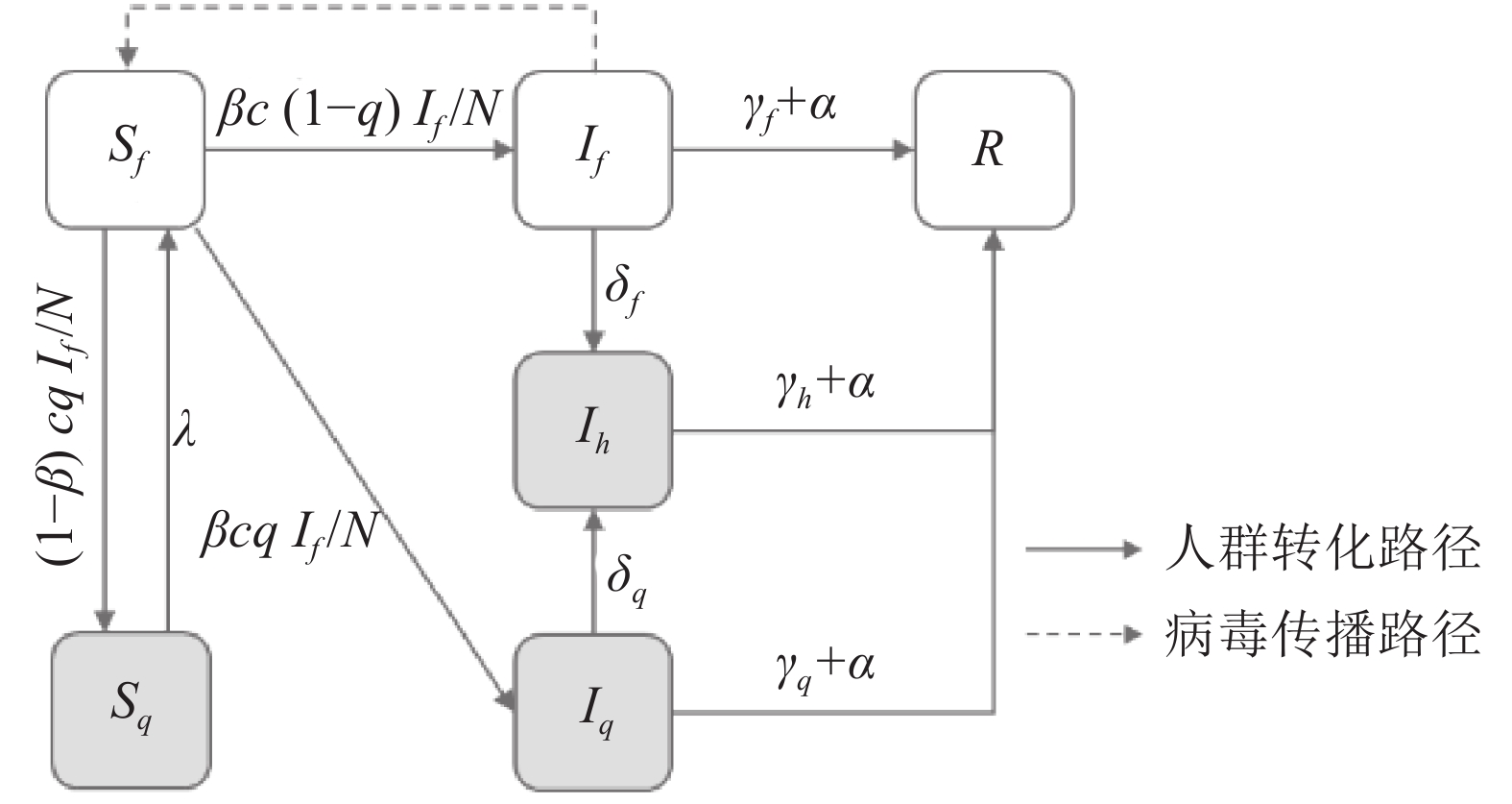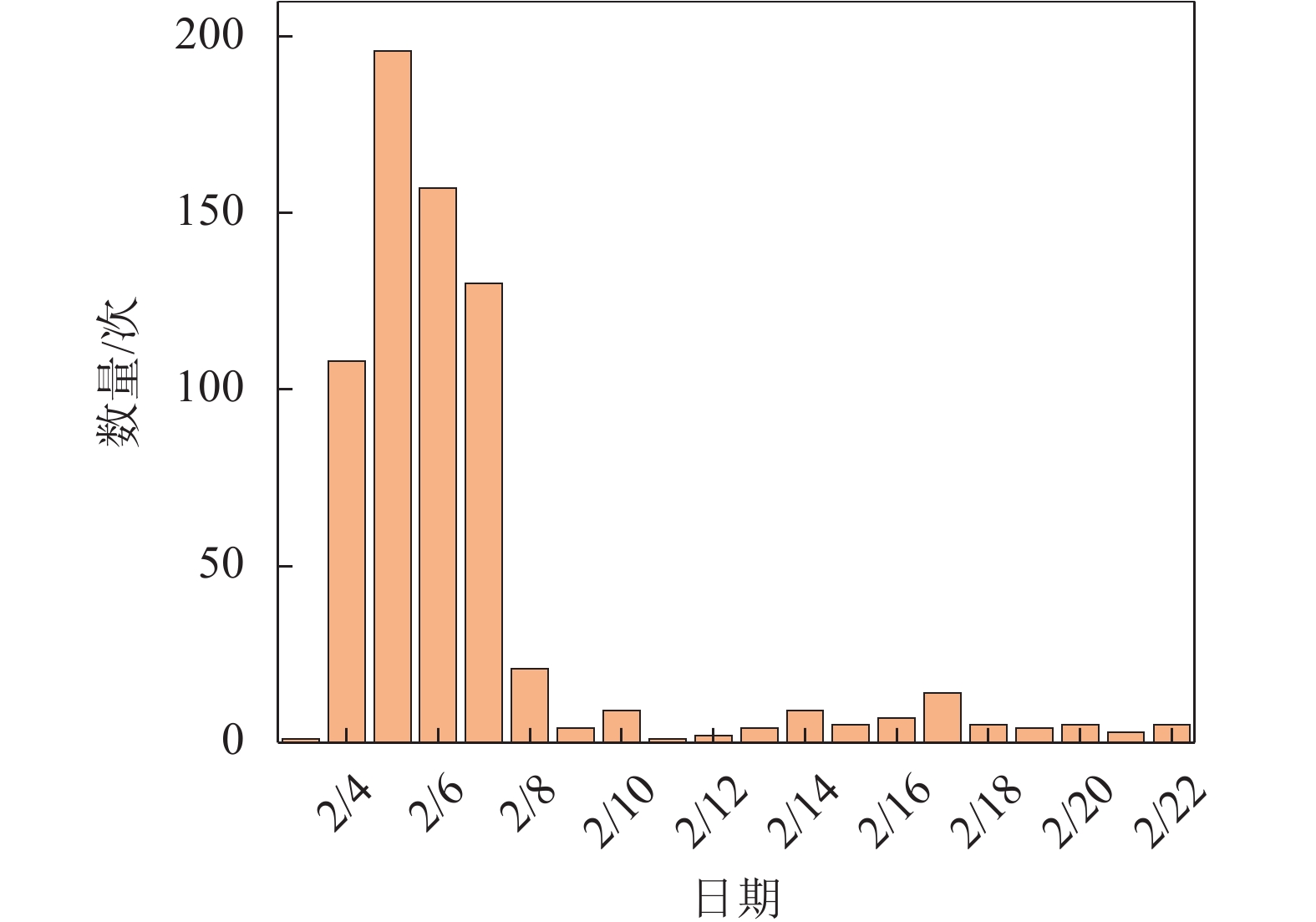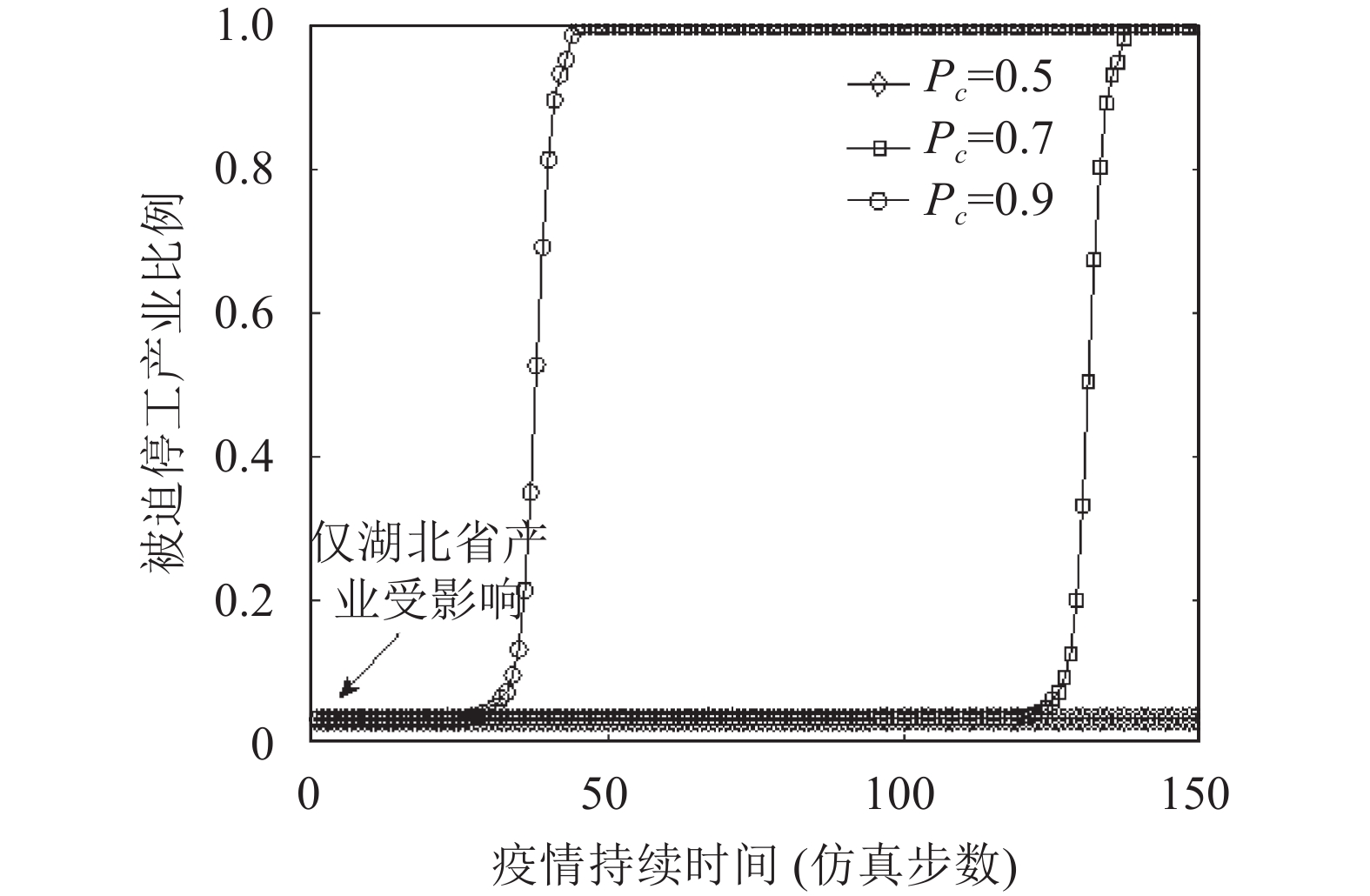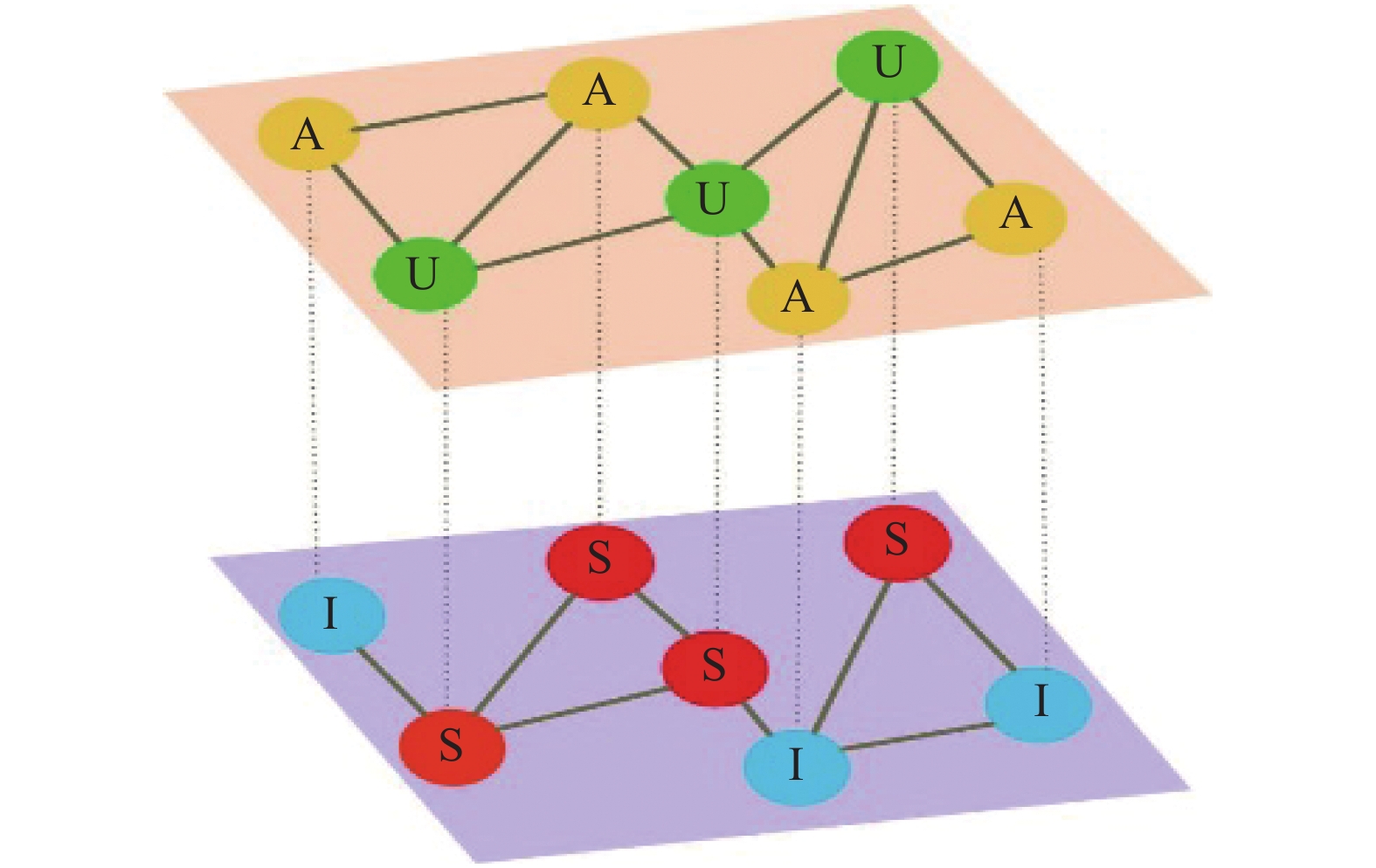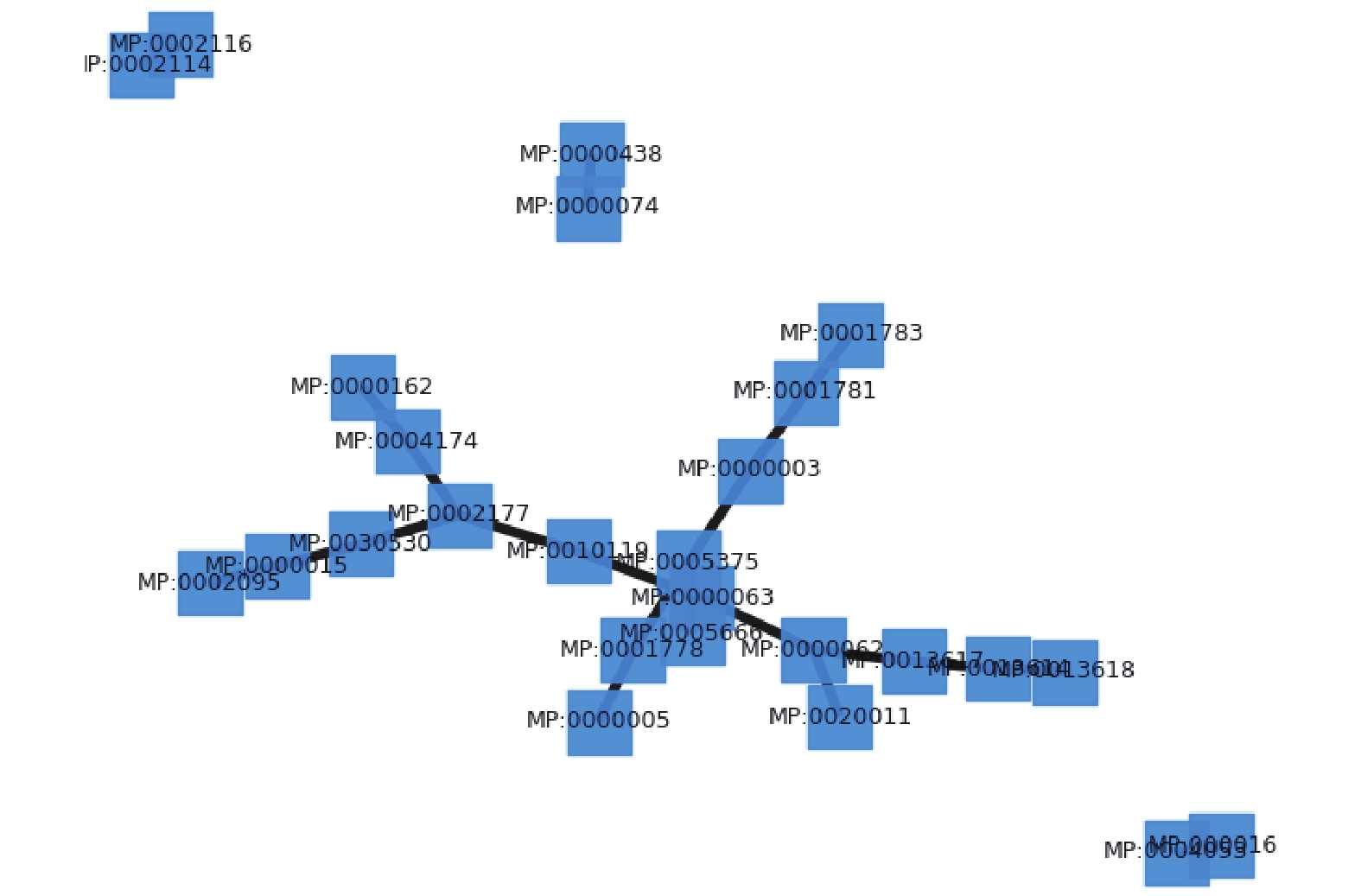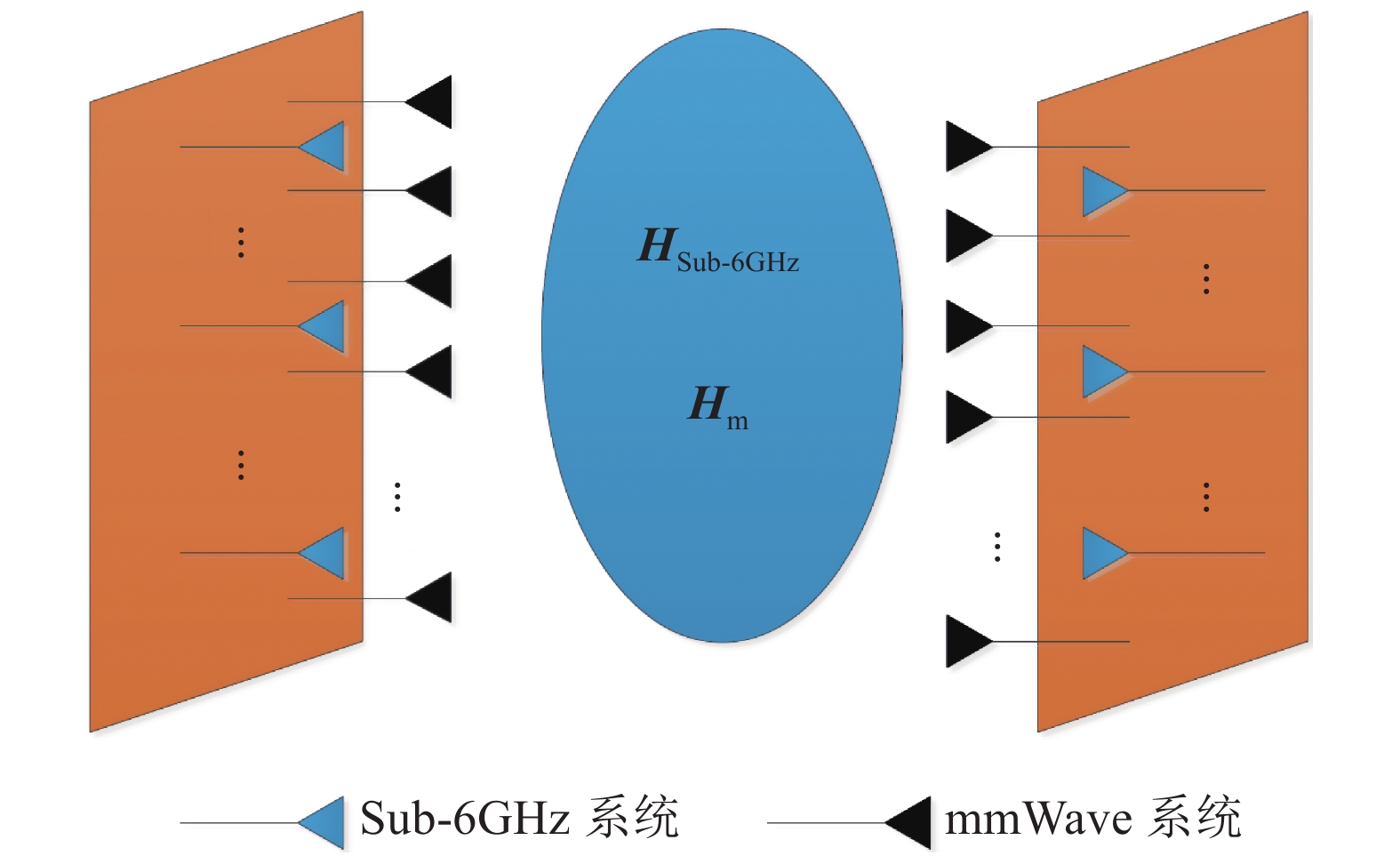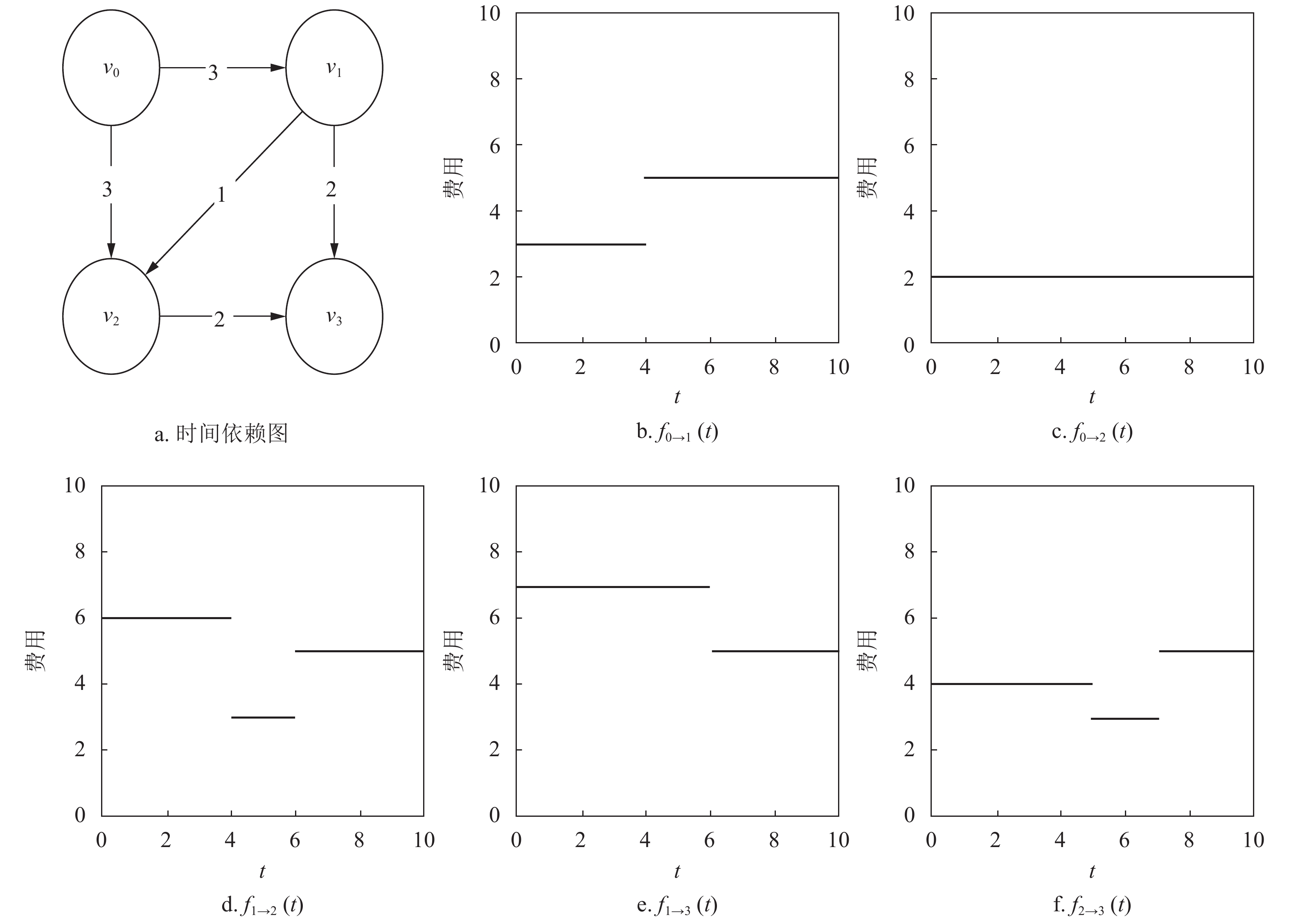2020 Vol. 49, No. 3
2020, 49(3): 321-323.
Abstract:
2020, 49(3): 324-329.
doi: 10.12178/1001-0548.2020033
Abstract:
In this paper, we provide a statistical analysis of population movements leaving Wuhan based on mass population movement information which is collected by geographic services of Tencent and Baidu. Firstly, we find that the five million people leaving Wuhan before the official announcement that they will close the exits are not much different from the normal population movement during the previous Spring Festival travel rush. However, small portion of the population poured out of Wuhan in the last period before the exits closed. Secondly, according to statistics of the destination cities of the outflow population from Wuhan starting from 2020, we find that the destination distribution of folks in 2020 was basically same as that in previous years. Finally, the influence of the population leaving Wuhan on epidemic spread is analyzed. We find that the role of incubation period must be considered when measuring this influence. This study is helpful for relevant personnel to grasp the speed of epidemic spread, assess the risk of epidemic, and provides reference to predict and stop disease spreading.
In this paper, we provide a statistical analysis of population movements leaving Wuhan based on mass population movement information which is collected by geographic services of Tencent and Baidu. Firstly, we find that the five million people leaving Wuhan before the official announcement that they will close the exits are not much different from the normal population movement during the previous Spring Festival travel rush. However, small portion of the population poured out of Wuhan in the last period before the exits closed. Secondly, according to statistics of the destination cities of the outflow population from Wuhan starting from 2020, we find that the destination distribution of folks in 2020 was basically same as that in previous years. Finally, the influence of the population leaving Wuhan on epidemic spread is analyzed. We find that the role of incubation period must be considered when measuring this influence. This study is helpful for relevant personnel to grasp the speed of epidemic spread, assess the risk of epidemic, and provides reference to predict and stop disease spreading.
2020, 49(3): 330-338.
doi: 10.12178/1001-0548.2020030
Abstract:
The number of COVID-19 infected persons in Wuhan is estimated by statistically analyzing the ratio of daily confirmed cases number data of COVID-19 in 50 cities in China from January 29, 2020 to February 9, 2020 owing to Wuhan migration. The study finds that the mean and median of diagnosis rate of 15 cities in Hubei Province are lower than that of 35 cities outside Hubei Province. As of February 9, 2020, using the mean, median and maximum values of diagnosis rate in inner cities of Hubei Province, it is estimated that the number of people infected in Wuhan is 2.1 times, 2 times and 3.9 times of those who have been diagnosed, respectively, while using the mean, median and maximum values of the diagnosis rate in cities outside the province, it is estimated that the number of people infected in Wuhan is 3.6 times, 2.6 times and 8.7 times of those who have been diagnosed, respectively. The mean and median of diagnosis rate in cities in and out of Hubei Province are estimated robustly by bootstrap method.
The number of COVID-19 infected persons in Wuhan is estimated by statistically analyzing the ratio of daily confirmed cases number data of COVID-19 in 50 cities in China from January 29, 2020 to February 9, 2020 owing to Wuhan migration. The study finds that the mean and median of diagnosis rate of 15 cities in Hubei Province are lower than that of 35 cities outside Hubei Province. As of February 9, 2020, using the mean, median and maximum values of diagnosis rate in inner cities of Hubei Province, it is estimated that the number of people infected in Wuhan is 2.1 times, 2 times and 3.9 times of those who have been diagnosed, respectively, while using the mean, median and maximum values of the diagnosis rate in cities outside the province, it is estimated that the number of people infected in Wuhan is 3.6 times, 2.6 times and 8.7 times of those who have been diagnosed, respectively. The mean and median of diagnosis rate in cities in and out of Hubei Province are estimated robustly by bootstrap method.
2020, 49(3): 339-344.
doi: 10.12178/1001-0548.2020144
Abstract:
It is significant to formulate effective measures to contain the spread of serious infectious diseases such as COVID-19, especially in the early stage of spread. Effective reproduction number is one of the key parameters to evaluate the effectiveness. It is difficult to estimate the effective reproduction number due to the incomplete symptom onsets. A model based on Monte Carlo method is proposed to estimate the effective reproduction number by using small number of symptom onsets. The control efficacy of Chinese mainland and some international countries is evaluated by the estimation of effective reproduction number. COVID-19 was effectively suppressed in two weeks after introducing A-level control measure at January 20, 2020. The containment of COVID-19 in Republic of Korea has also achieved some progresses.
It is significant to formulate effective measures to contain the spread of serious infectious diseases such as COVID-19, especially in the early stage of spread. Effective reproduction number is one of the key parameters to evaluate the effectiveness. It is difficult to estimate the effective reproduction number due to the incomplete symptom onsets. A model based on Monte Carlo method is proposed to estimate the effective reproduction number by using small number of symptom onsets. The control efficacy of Chinese mainland and some international countries is evaluated by the estimation of effective reproduction number. COVID-19 was effectively suppressed in two weeks after introducing A-level control measure at January 20, 2020. The containment of COVID-19 in Republic of Korea has also achieved some progresses.
2020, 49(3): 345-348.
doi: 10.12178/1001-0548.2020037
Abstract:
A generalized growth model is applied to fit the time series of cumulative confirmed cases between Jan. 15 to Feb. 15, 2020. Moreover, the same formula is also applied to the time series of cumulative susceptive cases and cumulative close contact cases from Jan. 23 to Feb. 15, 2020. The model tallies with data published by the National Health Commission. The sub-exponential and sub-linear growth reflect the time heterogeneity during the transmission of COVID-19, which provide the reference to the prediction of the growth trend of the transmission.
A generalized growth model is applied to fit the time series of cumulative confirmed cases between Jan. 15 to Feb. 15, 2020. Moreover, the same formula is also applied to the time series of cumulative susceptive cases and cumulative close contact cases from Jan. 23 to Feb. 15, 2020. The model tallies with data published by the National Health Commission. The sub-exponential and sub-linear growth reflect the time heterogeneity during the transmission of COVID-19, which provide the reference to the prediction of the growth trend of the transmission.
2020, 49(3): 349-356.
doi: 10.12178/1001-0548.2020067
Abstract:
The purpose of this paper is to reveal the spread dynamics of COVID-19, SARS and MERS. Based on the growth rate and infection inhibition constant of infectious diseases, the propagation growth model of infectious diseases is established, and then the parameters of the propagation growth model of three coronavirus, SARS-CoV-2, SARS-CoV and MERS-CoV, are obtained by nonlinear fitting. The analysis shows that the growth rate of SARS-CoV-2 is about twice that of SARS-CoV and MERS-CoV, and the doubling period of SARS-CoV-2 is two to three days. The infection inhibition constant in Hubei province is two orders of magnitude lower than that in other areas, which is consistent with the situation in Hubei.
The purpose of this paper is to reveal the spread dynamics of COVID-19, SARS and MERS. Based on the growth rate and infection inhibition constant of infectious diseases, the propagation growth model of infectious diseases is established, and then the parameters of the propagation growth model of three coronavirus, SARS-CoV-2, SARS-CoV and MERS-CoV, are obtained by nonlinear fitting. The analysis shows that the growth rate of SARS-CoV-2 is about twice that of SARS-CoV and MERS-CoV, and the doubling period of SARS-CoV-2 is two to three days. The infection inhibition constant in Hubei province is two orders of magnitude lower than that in other areas, which is consistent with the situation in Hubei.
2020, 49(3): 357-361.
doi: 10.12178/1001-0548.2020027
Abstract:
Based on the early behavior of COVID-19 until February 1st, the SIR model is modified to solve the dynamic equation of virus evolution by using the number of susceptible persons, the probability of infection and the latent infection rate. The change trend of infected persons is studied, and the influence of government administrative actions on the trend is analyzed. The results showed that after January 24th, 2020, the administrative action of the government has effectively slowed down the spread virus and the number of infected people decreased obviously. The number of current infections had reduced more than a half compared with the previous trend forecast according the trend of January 24th, 2020. The number of susceptible persons, the probability of infection and the latent infection rate were all greatly reduced. Based on the current trend and the optimal parameters, it is predicted that the outbreak will peak around February 9th, 2020 and then decline.
Based on the early behavior of COVID-19 until February 1st, the SIR model is modified to solve the dynamic equation of virus evolution by using the number of susceptible persons, the probability of infection and the latent infection rate. The change trend of infected persons is studied, and the influence of government administrative actions on the trend is analyzed. The results showed that after January 24th, 2020, the administrative action of the government has effectively slowed down the spread virus and the number of infected people decreased obviously. The number of current infections had reduced more than a half compared with the previous trend forecast according the trend of January 24th, 2020. The number of susceptible persons, the probability of infection and the latent infection rate were all greatly reduced. Based on the current trend and the optimal parameters, it is predicted that the outbreak will peak around February 9th, 2020 and then decline.
2020, 49(3): 362-368.
doi: 10.12178/1001-0548.2020063
Abstract:
The coronavirus diseases around the end of 2019 (COVID-19) has spreading within open space and the parameters of this dynamic system are time variant. As consequences, existed models are impractical for real-time forecasting of the COVID-19 trend. Therefore, this study provides a real-time trend forecasting model called extreme IR model with the propagation law. Based on SIR model, the propagation of COVID-19 is simplified to three states. Also, the model uses extreme learning machine to generate the parameters of each state. As a result, the proposed model can evaluate time-variant parameter and predict the number of confirmed cases, dead cases and recovered cases during spreading process. The experiment demonstrates that the extreme IR model achieves accurate real-time prediction. Hence, this paper provides an effective approach to analyze the trend of the diseases.
The coronavirus diseases around the end of 2019 (COVID-19) has spreading within open space and the parameters of this dynamic system are time variant. As consequences, existed models are impractical for real-time forecasting of the COVID-19 trend. Therefore, this study provides a real-time trend forecasting model called extreme IR model with the propagation law. Based on SIR model, the propagation of COVID-19 is simplified to three states. Also, the model uses extreme learning machine to generate the parameters of each state. As a result, the proposed model can evaluate time-variant parameter and predict the number of confirmed cases, dead cases and recovered cases during spreading process. The experiment demonstrates that the extreme IR model achieves accurate real-time prediction. Hence, this paper provides an effective approach to analyze the trend of the diseases.
2020, 49(3): 369-374.
doi: 10.12178/1001-0548.2020029
Abstract:
The COVID-19 has severely affected the country, and people's social and economic lives have been greatly disrupted. Based on the complex network theory, a SEIR dynamic model of the COVID-19 epidemic with a latency period is established in this paper. By setting three scenarios of different incubation periods of the virus, based on national and partial epidemic data, the model parameters are simulated and analyzed for different scenarios. The inflection points of the three cases are predicted, and the results showed that the model analysis is basically consistent with the true performance of the epidemic development. Finally, the paper concludes with specific countermeasures and suggestions for strengthening the prevention and control of the epidemic.
The COVID-19 has severely affected the country, and people's social and economic lives have been greatly disrupted. Based on the complex network theory, a SEIR dynamic model of the COVID-19 epidemic with a latency period is established in this paper. By setting three scenarios of different incubation periods of the virus, based on national and partial epidemic data, the model parameters are simulated and analyzed for different scenarios. The inflection points of the three cases are predicted, and the results showed that the model analysis is basically consistent with the true performance of the epidemic development. Finally, the paper concludes with specific countermeasures and suggestions for strengthening the prevention and control of the epidemic.
2020, 49(3): 375-382.
doi: 10.12178/1001-0548.2020083
Abstract:
In this paper the concept of ‘undiscovered people’ is introduced into traditional SEIR model for the research of COVID-19. The model fitting with result analysis is performed by utilizing COVID-19 data from 25 January 2020 to 22 February 2020. And then the fitted model is used to simulate the evolution after February 22, 2020. The results show that the introduction of ‘undiscovered people’ has a significant improvement in fitting and prediction performance, reducing the fitting error by 50% to 70%. The fitting coefficient shows that the virus-laden population accounted for 30% and 5% of exposed people, respectively, in the early and late stages of epidemic. The diagnosed probability of virus-laden population has increased from 7% to 40%, which shows that nucleic acid detection technology is becoming matured. Initial number of undiscovered people is about 70 000, and under effective national control, it is currently controlled at about 2 500. It is predicted that the “inflection point” will be mid-March, then residents can return to normal life at the end of April, and the cumulative diagnosis is about 100 000 finally.
In this paper the concept of ‘undiscovered people’ is introduced into traditional SEIR model for the research of COVID-19. The model fitting with result analysis is performed by utilizing COVID-19 data from 25 January 2020 to 22 February 2020. And then the fitted model is used to simulate the evolution after February 22, 2020. The results show that the introduction of ‘undiscovered people’ has a significant improvement in fitting and prediction performance, reducing the fitting error by 50% to 70%. The fitting coefficient shows that the virus-laden population accounted for 30% and 5% of exposed people, respectively, in the early and late stages of epidemic. The diagnosed probability of virus-laden population has increased from 7% to 40%, which shows that nucleic acid detection technology is becoming matured. Initial number of undiscovered people is about 70 000, and under effective national control, it is currently controlled at about 2 500. It is predicted that the “inflection point” will be mid-March, then residents can return to normal life at the end of April, and the cumulative diagnosis is about 100 000 finally.
2020, 49(3): 383-391.
doi: 10.12178/1001-0548.2020109
Abstract:
The statistical characteristics of the human mobility among different cities in the spreading of COVID-19 can be described by SI spreading model. P-SI models are presented to investigate how COVID-19 spreads or diffuses in Hubei and the other 4 provinces. Based on empirical data, some experiments are then conducted under the framework of the P-SI models. The experimental results demonstrate that the P-SI models can describe the number of daily new infected people caused by COVID-19 in Hubei and the other 4 provinces according to the empirical data. In addition, the P-SI models can also predict the number of daily new infected people in the other 4 provinces after 1/24 according to the empirical data before 1/23. The P-SI models are steps toward the understanding of COVID-19’s spreading characteristics, which provides supports to isolate the source of COVID-19, to prevent and slow down the spreading of COVID-19, and to roll out effective measures for COVID-19’s prevention and control.
The statistical characteristics of the human mobility among different cities in the spreading of COVID-19 can be described by SI spreading model. P-SI models are presented to investigate how COVID-19 spreads or diffuses in Hubei and the other 4 provinces. Based on empirical data, some experiments are then conducted under the framework of the P-SI models. The experimental results demonstrate that the P-SI models can describe the number of daily new infected people caused by COVID-19 in Hubei and the other 4 provinces according to the empirical data. In addition, the P-SI models can also predict the number of daily new infected people in the other 4 provinces after 1/24 according to the empirical data before 1/23. The P-SI models are steps toward the understanding of COVID-19’s spreading characteristics, which provides supports to isolate the source of COVID-19, to prevent and slow down the spreading of COVID-19, and to roll out effective measures for COVID-19’s prevention and control.
2020, 49(3): 392-398.
doi: 10.12178/1001-0548.2020158
Abstract:
The epidemic of COVID-19 has been effectively controlled in China, which provides an empirical basis for intervention analysis. An extended SIR transmission model with heterogeneous force of infectiousness is presented including three fractals sub-models of Wuhan, Hubei and China. The model is built upon the data from January 20 to March 23, 2020. The Markov chain Monte Carlo (MCMC) Gibbs sampling and machine learning of Gaussian process regression are applied to solve the parameters estimation and the sensitivity analysis is used in various scenarios. The model has a breakthrough in parameter setting and accuracy optimization. It is found that contact reduction is the most effective core lever to control the epidemic, with 3.5 times or more sensitivity as much as other levers. The asymmetric marginal effect in strong and weak scenarios proves that Chinese controlling strategy is close to the Pareto Optimality. The intervention effectiveness of COVID-19 in China is evaluated by simulation analysis. The result provides valuable reference for China and other countries to judge the epidemic risk, control the intervention pace, and formulate prevention strategies in the future.
The epidemic of COVID-19 has been effectively controlled in China, which provides an empirical basis for intervention analysis. An extended SIR transmission model with heterogeneous force of infectiousness is presented including three fractals sub-models of Wuhan, Hubei and China. The model is built upon the data from January 20 to March 23, 2020. The Markov chain Monte Carlo (MCMC) Gibbs sampling and machine learning of Gaussian process regression are applied to solve the parameters estimation and the sensitivity analysis is used in various scenarios. The model has a breakthrough in parameter setting and accuracy optimization. It is found that contact reduction is the most effective core lever to control the epidemic, with 3.5 times or more sensitivity as much as other levers. The asymmetric marginal effect in strong and weak scenarios proves that Chinese controlling strategy is close to the Pareto Optimality. The intervention effectiveness of COVID-19 in China is evaluated by simulation analysis. The result provides valuable reference for China and other countries to judge the epidemic risk, control the intervention pace, and formulate prevention strategies in the future.
2020, 49(3): 399-407.
doi: 10.12178/1001-0548.2020172
Abstract:
With the stabilization of the COVID-19 in China, the resumption of study has become the hottest issue most concerned by the people. The long-time gathering and face-to-face contact of students and teachers in schools increase the risk of their mutual infection. Although school suspension is generally considered to be the most feasible strategy to alleviate epidemics, large-scale isolation is often accompanied by high socio-economic costs and even social panic. Therefore, when an outbreak occurs in schools, we need to try to use more detailed scientific prevention and control measures. In this study, the spread of the COVID-19 in schools is simulated based on real interpersonal contact data, and the prevention and control measures are formulated by calculating the effective distance among students. This study finds that students have more contact with students in the same class and grade in schools. Therefore, when cases are found in schools, the development of the epidemic can be controlled by closing the patient's class and grade in time, and it will achieve similar or even better results than the closed school. In addition, in the absence of closure and the application of prevention and control measures, the impact of the proportion of asymptomatic patients and the incubation period infectivity in school outbreaks are analyzed, respectively. After the prevention and control measures are applied, the epidemic situation in each case will be controlled, and it will soon usher in a time when the epidemic situation improves. The research in this paper helps schools to select appropriate prevention and control measures, and accurately assess the impact of asymptomatic patients and incubation period infectivity on the epidemic.
With the stabilization of the COVID-19 in China, the resumption of study has become the hottest issue most concerned by the people. The long-time gathering and face-to-face contact of students and teachers in schools increase the risk of their mutual infection. Although school suspension is generally considered to be the most feasible strategy to alleviate epidemics, large-scale isolation is often accompanied by high socio-economic costs and even social panic. Therefore, when an outbreak occurs in schools, we need to try to use more detailed scientific prevention and control measures. In this study, the spread of the COVID-19 in schools is simulated based on real interpersonal contact data, and the prevention and control measures are formulated by calculating the effective distance among students. This study finds that students have more contact with students in the same class and grade in schools. Therefore, when cases are found in schools, the development of the epidemic can be controlled by closing the patient's class and grade in time, and it will achieve similar or even better results than the closed school. In addition, in the absence of closure and the application of prevention and control measures, the impact of the proportion of asymptomatic patients and the incubation period infectivity in school outbreaks are analyzed, respectively. After the prevention and control measures are applied, the epidemic situation in each case will be controlled, and it will soon usher in a time when the epidemic situation improves. The research in this paper helps schools to select appropriate prevention and control measures, and accurately assess the impact of asymptomatic patients and incubation period infectivity on the epidemic.
2020, 49(3): 408-414.
doi: 10.12178/1001-0548.2020079
Abstract:
Based on the Selenium data mining technology, the epidemiological characteristics of real help cases in Sina Weibo were obtained by the analysis of 690 valid cases posted in the Sina Weibo “Pneumonia Patients Asking for Help” topic from February 4 to February 22, 2020. The research showed that 97.6% of the patients seeking for help came from Wuhan, mainly centralized in Wuchang, Tongkou, Hanyang etc. urban areas, and the proportion is directly proportional to the local medical resources and population density. The cases of Weibo help were mainly distributed from February 4 to February 7, 2020. With the relief of medical resources, the number of cases seeking help through social media decreased significantly. The distribution of patients, whose diagnosed date was mainly from January 16 to February 6, 2020, was basically consistent with the case information released by the Chinese Center for Disease Control and Prevention (CCDC). The median age of patients seeking for help was 60 years old, which was much higher than the data released by the CCDC but was roughly coincident with the data of the central hospital of Wuhan. The results of this study indicate that when dealing with major outbreaks of infectious diseases, social media are equally important in epidemiological analysis as well as the role in the dissemination of public opinion. Based on the wide adoption and timeliness nature of social media, it will be helpful for decision-makers to quickly grasp the real-world situation as it is combined with data mining or big data analysis.
Based on the Selenium data mining technology, the epidemiological characteristics of real help cases in Sina Weibo were obtained by the analysis of 690 valid cases posted in the Sina Weibo “Pneumonia Patients Asking for Help” topic from February 4 to February 22, 2020. The research showed that 97.6% of the patients seeking for help came from Wuhan, mainly centralized in Wuchang, Tongkou, Hanyang etc. urban areas, and the proportion is directly proportional to the local medical resources and population density. The cases of Weibo help were mainly distributed from February 4 to February 7, 2020. With the relief of medical resources, the number of cases seeking help through social media decreased significantly. The distribution of patients, whose diagnosed date was mainly from January 16 to February 6, 2020, was basically consistent with the case information released by the Chinese Center for Disease Control and Prevention (CCDC). The median age of patients seeking for help was 60 years old, which was much higher than the data released by the CCDC but was roughly coincident with the data of the central hospital of Wuhan. The results of this study indicate that when dealing with major outbreaks of infectious diseases, social media are equally important in epidemiological analysis as well as the role in the dissemination of public opinion. Based on the wide adoption and timeliness nature of social media, it will be helpful for decision-makers to quickly grasp the real-world situation as it is combined with data mining or big data analysis.
2020, 49(3): 415-424.
doi: 10.12178/1001-0548.2020092
Abstract:
The outbreak and rapid spread of Covid-19 epidemic have brought severe challenges to the regional economy of China. The epidemic has led to interruptions in supply and decline in demand in some industries, causing supply chain risk spread through the industry chain to the entire network, which is very likely to trigger systemic risks. In order to simulate the risk contagion effect of the regional industrial supply chain under the influence of the epidemic, a network cascading failure model based on China's regional industrial network is proposed. We simulate the propagation of production suspension and liquidity risk in the case of unexpected interruption of supply and decline in demand in Hubei province as well as the rest part of China. The results show that risk propagation exhibits an abrupt transition with a critical time point. The risk spread is relatively slow and stable before the critical point. Once the critical point is exceeded, the accelerated spread makes the entire industrial network blackout in a short period. We also show that under the impact of supply-side and demand-side shocks, different industries have heterogeneous effects on systemic risk levels. re industrial network blackout in a short period. We also show that different industries have heterogeneous impact on systemic risk of the industry network under shocks from supply and demand side.
The outbreak and rapid spread of Covid-19 epidemic have brought severe challenges to the regional economy of China. The epidemic has led to interruptions in supply and decline in demand in some industries, causing supply chain risk spread through the industry chain to the entire network, which is very likely to trigger systemic risks. In order to simulate the risk contagion effect of the regional industrial supply chain under the influence of the epidemic, a network cascading failure model based on China's regional industrial network is proposed. We simulate the propagation of production suspension and liquidity risk in the case of unexpected interruption of supply and decline in demand in Hubei province as well as the rest part of China. The results show that risk propagation exhibits an abrupt transition with a critical time point. The risk spread is relatively slow and stable before the critical point. Once the critical point is exceeded, the accelerated spread makes the entire industrial network blackout in a short period. We also show that under the impact of supply-side and demand-side shocks, different industries have heterogeneous effects on systemic risk levels. re industrial network blackout in a short period. We also show that different industries have heterogeneous impact on systemic risk of the industry network under shocks from supply and demand side.
2020, 49(3): 425-430.
doi: 10.12178/1001-0548.2020201
Abstract:
This article collected the information on family cluster confirmed cases of COVID-19 from Shenzhen Municipal Health Commission as an example. The first and second generations cases were identified according to the time of symptoms onset. Comparing the theoretical value of the second-generation cases calculated by the numerical model and the family structural network model with the actual value, the article found that the proportion of the second-generation cases in family cluster cases of females were significantly higher than that of males. The quantitative results support the hypothesis that women play the major part of the nursing role at home, and statically suggest that women were in higher susceptibility than men while implementing home quarantine as the main epidemic control measurement. Based on the current situation, the article listed out some advices to reduce the infection risk of women at the end.
This article collected the information on family cluster confirmed cases of COVID-19 from Shenzhen Municipal Health Commission as an example. The first and second generations cases were identified according to the time of symptoms onset. Comparing the theoretical value of the second-generation cases calculated by the numerical model and the family structural network model with the actual value, the article found that the proportion of the second-generation cases in family cluster cases of females were significantly higher than that of males. The quantitative results support the hypothesis that women play the major part of the nursing role at home, and statically suggest that women were in higher susceptibility than men while implementing home quarantine as the main epidemic control measurement. Based on the current situation, the article listed out some advices to reduce the infection risk of women at the end.
2020, 49(3): 431-437.
doi: 10.12178/1001-0548.2019163
Abstract:
Recently, studies on the interaction between disease transmission and awareness transmission based on two-layer networks have attracted much attention. Within such a framework, infectious disease is propagated through physical contact networks, while the diffusion of awareness is transmitted through virtual contact network. Moreover, the nodes on two layers are the same, but the edges connecting nodes in the two layers are different. Most of the existing models assume that the diffusion of awareness precedes the spread of disease (hereinafter referred to as ordered model). In real cases, it is difficult to distinguish the order of disease transmission from that of awareness diffusion, thus, this paper proposes a model without considering the order of two spreading processions (concurrent model for short). We find that the two models yield the same epidemic threshold, but have different influence on the spreading sizes. When the transmission rate of awareness is low, the epidemic size of concurrent model is smaller than that of ordered model. However, with the increase of the transmission rate of awareness, the result is reversed, that is, the epidemic size of the concurrent model is larger than that of ordered model.
Recently, studies on the interaction between disease transmission and awareness transmission based on two-layer networks have attracted much attention. Within such a framework, infectious disease is propagated through physical contact networks, while the diffusion of awareness is transmitted through virtual contact network. Moreover, the nodes on two layers are the same, but the edges connecting nodes in the two layers are different. Most of the existing models assume that the diffusion of awareness precedes the spread of disease (hereinafter referred to as ordered model). In real cases, it is difficult to distinguish the order of disease transmission from that of awareness diffusion, thus, this paper proposes a model without considering the order of two spreading processions (concurrent model for short). We find that the two models yield the same epidemic threshold, but have different influence on the spreading sizes. When the transmission rate of awareness is low, the epidemic size of concurrent model is smaller than that of ordered model. However, with the increase of the transmission rate of awareness, the result is reversed, that is, the epidemic size of the concurrent model is larger than that of ordered model.
2020, 49(3): 438-444.
doi: 10.12178/1001-0548.2019133
Abstract:
With the completion of genome sequencing and the continuous development of gene technology, the pathogenic genes of some diseases are gradually identified. At present, people have grasped the pathogenic causes of some diseases through scientific experiments, but the pathogenic causes of most diseases, especially those related to genes, are still unknown. In this paper, the mouse data with 85% homology similarity to human is used as the research object. The disease phenotype data set, pathogenic gene data set and confirmed phenotype-gene association data set are constructed into a double-layer coupled network. The data are analyzed and mined by meta-path random walk method, and the uncertainties are predicted on the basis of confirmed phenotype-gene association data. The proposed algorithm achieves better prediction results compared with other algorithms.
With the completion of genome sequencing and the continuous development of gene technology, the pathogenic genes of some diseases are gradually identified. At present, people have grasped the pathogenic causes of some diseases through scientific experiments, but the pathogenic causes of most diseases, especially those related to genes, are still unknown. In this paper, the mouse data with 85% homology similarity to human is used as the research object. The disease phenotype data set, pathogenic gene data set and confirmed phenotype-gene association data set are constructed into a double-layer coupled network. The data are analyzed and mined by meta-path random walk method, and the uncertainties are predicted on the basis of confirmed phenotype-gene association data. The proposed algorithm achieves better prediction results compared with other algorithms.
2020, 49(3): 445-452.
doi: 10.12178/1001-0548.2019110
Abstract:
For the purpose of coping with the intensive deployment of eNB (evolved NodeB) and AP (access point) in LWA (LTE WLAN aggregation) networks, and a situation in which the user is unable to satisfy their needs, this paper proposes an access point selection algorithm for LWA networks based on optimal weighted multi-attribute decision (OWMAD). First, the algorithm pre-collects the access point attributes and establishes the attribute set, then designs the optimal weights of the decision attributes and overlays the decision matrix with the optimal weight vector. Finally, the optimal network access point is determined according to the results of the comprehensive performance of each access point. Simulation results show that the proposed algorithm can effectively improve the throughput of peripheral areas and the overall system, while reducing the average system delay and improving the user's quality of service.
For the purpose of coping with the intensive deployment of eNB (evolved NodeB) and AP (access point) in LWA (LTE WLAN aggregation) networks, and a situation in which the user is unable to satisfy their needs, this paper proposes an access point selection algorithm for LWA networks based on optimal weighted multi-attribute decision (OWMAD). First, the algorithm pre-collects the access point attributes and establishes the attribute set, then designs the optimal weights of the decision attributes and overlays the decision matrix with the optimal weight vector. Finally, the optimal network access point is determined according to the results of the comprehensive performance of each access point. Simulation results show that the proposed algorithm can effectively improve the throughput of peripheral areas and the overall system, while reducing the average system delay and improving the user's quality of service.
2020, 49(3): 453-457, 466.
doi: 10.12178/1001-0548.2018246
Abstract:
Millimeter-wave (mmWave) communication is a practicable scheme for big data communication, such as next-generation cellular communication. However, mmWave frequencies have an extremely large path loss, for this, hybrid analog/digital beamforming could serve as an awesome technique to reduce such loss. This paper concentrates on the channel state information acquirement problem in mmWave communication systems with massive multiple-input multiple-output (MIMO) arrays. Because the channel state information acquirement is a method of significant overhead, we consider an accurate channel estimation scheme with low overhead. This paper proposes using support information extracted at Sub-6GHz to aid the mmWave channel state information acquirement. We formulate mmWave channel state information acquirement as a compressive sensing problem and use generalized approximate message passing (GAMP) algorithm. We also extend the GAMP algorithm with support distribution information from Sub-6GHz channel. Furthermore, based on the K nearest neighbor idea, we redesign the GAMP algorithm depending on Sub-6GHz support distribution information. Simulation results show that the out-of-band information aided mmWave channel estimation is capable of reducing the pilot overhead greatly and channel estimation accuracy can be improved as well.
Millimeter-wave (mmWave) communication is a practicable scheme for big data communication, such as next-generation cellular communication. However, mmWave frequencies have an extremely large path loss, for this, hybrid analog/digital beamforming could serve as an awesome technique to reduce such loss. This paper concentrates on the channel state information acquirement problem in mmWave communication systems with massive multiple-input multiple-output (MIMO) arrays. Because the channel state information acquirement is a method of significant overhead, we consider an accurate channel estimation scheme with low overhead. This paper proposes using support information extracted at Sub-6GHz to aid the mmWave channel state information acquirement. We formulate mmWave channel state information acquirement as a compressive sensing problem and use generalized approximate message passing (GAMP) algorithm. We also extend the GAMP algorithm with support distribution information from Sub-6GHz channel. Furthermore, based on the K nearest neighbor idea, we redesign the GAMP algorithm depending on Sub-6GHz support distribution information. Simulation results show that the out-of-band information aided mmWave channel estimation is capable of reducing the pilot overhead greatly and channel estimation accuracy can be improved as well.
2020, 49(3): 458-466.
doi: 10.12178/1001-0548.2019002
Abstract:
This paper proposes an efficient search to find a minimal cost path in a time-dependent graph. Current method discovers paths to the destination by expanding discovered paths originated from the source vertex. However, this blind search incurs large searching space, which lowers the query efficiency. The searching space is reduced in the following two ways. Firstly, during the search, the computation is confined within the valid time interval of each vertex to avoid useless computations. Besides, the costs of new expanded paths is computed not until the minimal cost of a path within a time interval of a vertex is correctly computed. Secondly, two searches are respectively invoked from the source vertex and the destination vertex, by which the searching space is roughly located in two small circles centered at the source and the destination. The bi-directional search stopping criteria as well as the way to regenerate the minimal cost path are discussed. The correctness of the proposed method is also theoretically proved. Finally, extensive experiments on large scale datasets confirm the efficiency of the proposed method.
This paper proposes an efficient search to find a minimal cost path in a time-dependent graph. Current method discovers paths to the destination by expanding discovered paths originated from the source vertex. However, this blind search incurs large searching space, which lowers the query efficiency. The searching space is reduced in the following two ways. Firstly, during the search, the computation is confined within the valid time interval of each vertex to avoid useless computations. Besides, the costs of new expanded paths is computed not until the minimal cost of a path within a time interval of a vertex is correctly computed. Secondly, two searches are respectively invoked from the source vertex and the destination vertex, by which the searching space is roughly located in two small circles centered at the source and the destination. The bi-directional search stopping criteria as well as the way to regenerate the minimal cost path are discussed. The correctness of the proposed method is also theoretically proved. Finally, extensive experiments on large scale datasets confirm the efficiency of the proposed method.
2020, 49(3): 467-472, 480.
doi: 10.12178/1001-0548.2019101
Abstract:
With the increasing incidence of brain tumors in modern society, the analysis of the survival cycle of patients with brain tumors has become increasingly significant in clinical practice. In order to solve the problem of low accuracy of the current method, this paper proposes a life cycle analysis system for brain tumor patients based on Adaboost. Firstly, preprocessed magnetic resonance images and obtained its region of interest (ROI) and segmentation part, then extracted the texture features of multi-sequence MR for brain tumor patients, and performed feature selection using mutual information as the evaluation standard to obtain feature subset. Finally, this article builds an analysis model with Adaboost.R2 as the core method, and uses the feature subset to complete the training and tuning of the analysis model to complete the analysis of the survival period of tumor patients. The cross-validation experimental results on Brats2018 training data confirm that the analysis accuracy of this system is better than the Top3 methods of Brats2018 challenge and the traditional regression analysis methods.
With the increasing incidence of brain tumors in modern society, the analysis of the survival cycle of patients with brain tumors has become increasingly significant in clinical practice. In order to solve the problem of low accuracy of the current method, this paper proposes a life cycle analysis system for brain tumor patients based on Adaboost. Firstly, preprocessed magnetic resonance images and obtained its region of interest (ROI) and segmentation part, then extracted the texture features of multi-sequence MR for brain tumor patients, and performed feature selection using mutual information as the evaluation standard to obtain feature subset. Finally, this article builds an analysis model with Adaboost.R2 as the core method, and uses the feature subset to complete the training and tuning of the analysis model to complete the analysis of the survival period of tumor patients. The cross-validation experimental results on Brats2018 training data confirm that the analysis accuracy of this system is better than the Top3 methods of Brats2018 challenge and the traditional regression analysis methods.
2020, 49(3): 473-480.
doi: 10.12178/1001-0548.2019108
Abstract:
It is affected by many negative factors to recognize human motions accurately, such as the affecting of the light intensity during motion data collecting, the vagueness and transformation of the human motion features. To decrease the effect of these adverse factors and improve the accuracy of motion recognition, the following contents are investigated in this paper. Firstly, the human joint data collected by Kinect are preprocessed to overcome the illumination problem. Secondly, encoding methods are proposed to encode the preprocessed data, and then the encoded data are inputted into CNN to extract human motion features automatically, making the description of motion feature easier. Finally, the CNN completes motion classification with SoftMax. These experiments show the proposed algorithm can achieve a high recognition accuracy (most of the F1 values are larger than 0.8) and can adapt to different data settings; the compound property data are better than single property data in single property tests and the F1 value can be 0.916; the F1 values in compound property tests are smaller than those of single property tests and the maximal decrease percentage can be 25%.
It is affected by many negative factors to recognize human motions accurately, such as the affecting of the light intensity during motion data collecting, the vagueness and transformation of the human motion features. To decrease the effect of these adverse factors and improve the accuracy of motion recognition, the following contents are investigated in this paper. Firstly, the human joint data collected by Kinect are preprocessed to overcome the illumination problem. Secondly, encoding methods are proposed to encode the preprocessed data, and then the encoded data are inputted into CNN to extract human motion features automatically, making the description of motion feature easier. Finally, the CNN completes motion classification with SoftMax. These experiments show the proposed algorithm can achieve a high recognition accuracy (most of the F1 values are larger than 0.8) and can adapt to different data settings; the compound property data are better than single property data in single property tests and the F1 value can be 0.916; the F1 values in compound property tests are smaller than those of single property tests and the maximal decrease percentage can be 25%.

 ISSN
ISSN 

